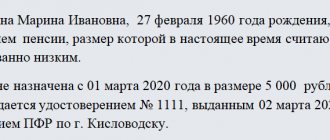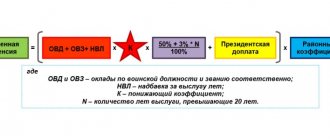Home / Labor Law / Payment and Benefits / Pension
Back
Published: March 27, 2016
Reading time: 11 min
4
16402
A number of regions of Russia are characterized by difficult climatic and other conditions associated with increased health hazards, as well as a high cost of living due to natural reasons. For this reason, various measures to support the population are applied at the local and regional level, aimed at equalizing income and maintaining material equality.
One of these tools is the use of regional coefficients, which are established at the level of the Government of the Russian Federation.
- Concept and determining factors
- What payments are subject to the regional coefficient?
- Regional coefficients in the Russian Federation in 2020
- How is the district coefficient used in calculations?
What is the "regional coefficient"?
The regional coefficient actually means a premium that is applied when calculating salaries, pensions and other benefits. Its value ranges from 1 to 2 depending on the region, and it is established by both federal and local legislative acts.
The coefficient is applied in regions that meet one of the following characteristics:
- Difficult climatic conditions: low temperature, poor climate, which generally negatively affects human health;
- Poor environmental conditions, which also have a detrimental effect on health;
- Low standard of living, determined by natural conditions, remoteness from other, more developed territories of the Russian Federation: for example, in the Far East, where now not only an increasing coefficient is applied, but also a number of programs aimed at developing and populating the region are actively operating.
The size of the coefficient directly depends on the difficulties of living in a particular territory. If the climate or ecology is not too bad, a minimum value is set. The largest allowance is given to those who work in harsh conditions.
Thus, salaries and pensions for residents of different cities may differ. They are calculated taking into account not only the coefficient, but also prices. Two different people who have worked the same number of years in the same positions will receive different salaries: a citizen who worked in the North will receive an increased benefit compared to someone who worked in another region, where lower prices are set and the coefficient is not applied.
How does the regional coefficient affect the size of the pension?
For other residents whose regions of residence also have regional coefficients for calculating wages, additional pension supplements that take these indicators into account are not applied. The regional coefficient for such residents is significant only when calculating total earnings for subsequent calculations and assignment of pension payments. This rule affects, for example, residents of the Krasnoyarsk Territory, living in its center and in the south of the region, because the designated territories no longer belong to the above-mentioned territories.
If a pensioner decides to move to another place of residence, the coefficient will be revised relative to the new region of residence. Fixed payments can be established regardless of the subsequent place of residence. But in this case, it is necessary to work for about 15 years in the regions of the Far North and 20 years in territories equivalent to them. In addition, a mandatory condition is the length of the insurance period (for men at least 25 years, and for women - from 20 years.
Legislation
The specifics of applying the increasing coefficient for salaries and pensions are established by several legislative acts:
| Law | Explanation | Additionally |
| Law of the Russian Federation of February 19, 1993 N 4520-1 | The coefficient is used when calculating salaries and benefits. In addition, pensioners can use compensation for travel to and from their vacation spot once every 2 years by contacting Social Security | |
| Art. 146 Labor Code of the Russian Federation | The labor of citizens working in special climatic conditions is paid at an increased rate. | Interest rates and coefficients apply |
| Art. 148 Labor Code of the Russian Federation | The salary of employees working in special regions cannot be lower than the established amount | Minimum wages are determined by regional legislation |
| Art. 316 Labor Code of the Russian Federation | When calculating salaries, coefficients established by the Government of the Russian Federation are applied. | Local authorities may introduce additional increasing coefficients, but funding will come from regional budgets |
When is the regional coefficient applied?
The use of the coefficient is relevant when calculating the following types of payments:
- Pensions: old age, disability, long service;
- Determination of the minimum wage for a specific region;
- Deduction of insurance contributions to the Pension Fund;
- Supplements for working in harmful or dangerous conditions;
- Bonuses, incentives, compensation;
- Basic salary of employees.
Important! The employer independently calculates remuneration taking into account the coefficient. Employees should not contact them to apply allowances. The same applies to pensions, but here benefits are assigned in the divisions of the Pension Fund.
What does the regional coefficient not apply to?
There are several types of payments for which the use of a multiplying factor is irrelevant:
- Vacation pay. They are calculated from average earnings, where the coefficient is already included, so it is not used when calculating vacation pay;
- Material aid. The employer is not obliged to provide it, but if this is provided for by the local acts of the institution, the coefficient is not applied when calculating such assistance, unless the rules provide otherwise;
- One-time bonuses. They are determined by employers independently and paid solely at their discretion;
- Payment of travel expenses for an employee sent to a region where there is no multiplying factor;
- The accrual of an allowance for work in the North - it already implies monetary compensation for work in special conditions, and cannot be increased by applying a coefficient.
It is worth considering that the coefficient applies to all citizens, regardless of the form of activity of the enterprises in which they work or have worked. For example, individual entrepreneurs must calculate payments according to the same rules as legal entities. As for pensioners, the calculation procedure is the same everywhere for them. The only difference is in the size of the coefficient: in one region it may be higher, in another – lower.
Impact on the amount of payment
Calculation of pension payments in the presence of years worked before 2002 can be implemented in two ways:
- according to the old rules, taking into account the calculated pension capital, into which the experience coefficients are converted;
- according to the updated formula (the fundamental rules are given in the Laws “On Labor Pensions in the Russian Federation,” registered under No. 173-FZ on December 17, 2001, and “On Insurance Pensions” No. 400-FZ, dated December 28, 2013).
As a result, when assigning a pension, the choice is made in favor of the method by which the amount of pension provision will be greater.
The coefficient directly affects the amount of payments after retirement. The higher the pension points, the greater the calculated value of the labor pension.
According to the formula, the length of service coefficient is multiplied with the value of the average earnings in the country for the 3rd quarter of 2001 and the ratio of the salary of the insured person for the period from 2000 to 2001 or for any other 5 years (until 2002) to the average monthly income in Russia for the corresponding time interval.
Regional coefficient by region
Let's look at the coefficient sizes in different regions. For example, in the Altai Territory, a single coefficient applies throughout the entire territory - 1.4. The same applies to the Republic of Bashkortostan, but here it is less – 1.4.
In the Yamal-Nenets Autonomous Okrug, the coefficient is used in Salekhard and adjacent territories - 1.8, and in the Khanty-Mansiysk Autonomous Okrug it is 1.7.
Thus, the value of the coefficient varies in all regions: if in one it can be 2, then in another it can be only 1. This is due to the fact that different climatic conditions operate in different territories.
“We must create optimal living conditions for citizens. Pensions and other social benefits are constantly indexed. In addition, for residents of the North, regional coefficients are used - digital values that allow increasing the amount of payments compared to other citizens who do not have to live and work in difficult weather conditions.”
YES. Medvedev, Chairman of the Government of the Russian Federation.
Regional coefficients in the Russian Federation in 2020
Current regional coefficients for 2020 are shown in the table:
If you want to find out how to solve your particular problem, please contact us through the online consultant form or call :
| The subject of the Russian Federation | Coefficient value |
| 2,0 |
| 1,8 |
| 1,7 |
| 1,6 |
| 1,5 |
| 1,4 |
| 1,3 |
| 1,2 |
| The Republic of Karelia is the entire territory except for areas with coefficients of 1.4 and 1.3. | 1,15 |
Regional coefficient when assigning a pension
If a citizen is involved in assigning a pension, the calculation of the coefficient is carried out by the employees of the Pension Fund independently.
Example No. 1: pension calculation taking into account the coefficient
The woman worked in Murmansk for 25 years and is entitled to a pension. In total, without taking into account the coefficient, she should receive 20,000 rubles, with it another amount comes out:
20,000 x 1.15 = 23,000 rubles, where 3,000 rubles. is added by applying a coefficient.
Note! If you have worked for at least 1-2 years in the North, but are applying for a pension in a region where the coefficient is not provided, you need to submit documents confirming your work experience in the northern territory. Only after this can you apply for an increased pension taking into account the coefficient.
How to apply for a pension?
To apply for old-age benefits, a few weeks before reaching retirement age you need to start collecting documents. The whole procedure looks like this step by step:
- Collect documents and submit along with your application. It is filled in on the spot. You should contact the territorial office of the Pension Fund at the place of registration.
- Wait for the results of document verification. Usually they are checked no more than 10 days. If there are no problems, a decision on granting benefits will be made. The money will start flowing into your bank account.
There are areas in the North where there are no bank branches. In this case, the money will arrive at the Post Office, as it was before. If necessary, you can have your pension delivered by postman or apply for it yourself.
Example No. 1: registration of a pension by a resident of the North
The man has worked in the North for more than 25 years, therefore, he has the right to receive early old-age benefits. He still has 5 years left before he reaches the standard old-age pension. To process payments and stop working, the citizen prepared documents and submitted them to the Pension Fund at his place of residence.
Based on the results of consideration of the application, the pension was assigned with all allowances and increasing coefficients in accordance with the region of work and residence.
Note! All payments are calculated by Pension Fund employees themselves. If you have comments on the calculation - you did not take into account the length of service, or incorrectly calculated the amount taking into account the IPC - you can express them orally or send a written complaint to the head of the Pension Fund. The period for consideration of requests is 30 calendar days; based on the results, you should be sent a written response.
Documents for assigning a pension
To apply for a pension you must provide the following:
- Statement;
- SNILS;
- Work book.
You will also need a passport. Copies are made of all documents, and the originals are returned to the applicant.
Grounds for refusal
They may refuse to grant old-age benefits if the citizen does not have sufficient grounds for registration: he has not reached retirement age, does not have enough experience for early registration, etc. Also, the basis may be the provision of an incomplete set of documents. In this case, you need to correct the problem and contact the Pension Fund again.
If you believe that your application for benefits was denied unreasonably, request a reasoned refusal in writing. In the future, you can use it to draw up a complaint to the head of the Pension Fund or submit documents for appeal to the court. The case will be considered through administrative proceedings.
Based on the results of the proceedings, the court will independently send a copy of the court decision to the Pension Fund of the Russian Federation. If it is ruled in your favor, Pension Fund employees will assign and recalculate your pension without unnecessary reminders. If you are not satisfied with the decision, you can appeal it through the appellate authority only before it comes into force.
Regional coefficients for wages and pensions
The regional coefficient was approved by the Decree of the Russian Government “On some measures for the social and economic development of the regions of the North” dated 02/04/1991 No. 76 in order to equalize the incomes and living standards of Russians in all regions of the country. What is this coefficient and what does it depend on? How is it calculated and what is it applied to? We will try to answer these questions in this article.
- material assistance and remuneration, but on the condition that the payments are one-time in nature and are not taken into account in the employment contract;
- vacation pay (the amount is calculated from the salary received when applying the regional coefficient);
- northern allowances (awarded for work in the territory of the KS). Northern payments and the multiplier are not interchangeable payments and do not affect each other.
FAQ
Question No. 1. Is the fixed part of the disability pension increased by the coefficient?
Yes, it is increasing. The same applies to the old age insurance pension.
Question No. 2. What length of service is required to receive an early northern pension?
Upon reaching retirement age, men and women must work for 15 years. If a woman has two or more children, the minimum length of service is reduced to 12 years. This applies to those who worked in the Far North. For equivalent areas, the minimum experience is 20 and 17 years, respectively.
Common errors
Mistake #1. If a person has worked in the north, but applies for a pension in a regular region, the coefficient will not be applied.
No, when calculating a pension, the coefficient will be used for the entire period of work in a special region.
Mistake #2. If a citizen has not worked in the north for a certain number of years, the pension coefficient will not be applied.
No, the minimum length of service is established only for early retirement. In other cases, all periods of work in the north are included in the calculation.
Regional coefficient and rules for its application in Russian regions in 2020
To calculate it, you need to take the amount of wages for the twelve months preceding the trip, taking into account the coefficient for Karelia, and divide by the number of working days. Multiply the resulting total by the number of days on a business trip. That is, the regional coefficient of Norilsk will not be taken into account.
- Salary from the date of entry into position (that is, actual earnings, including base and official salary, salary schedules).
- Additional payments to wages, including amounts for length of service (continuous service).
- Bonuses based on the results of the production year.
- Allowances for existing categories (tariff rates), excellence and academic degrees.
- Compensation for work at night, in dangerous or harmful conditions.
- Payments for temporary employment relationships and seasonal work.
- Minimum wage.
- Payments to employees working part-time or part-time.
- Pension (the right to use the regional coefficient when calculating a pension is retained only if you live in the territory for which such allowances are applied).
This is interesting: Do Pensioners Have the Right to Benefits in the Museum









